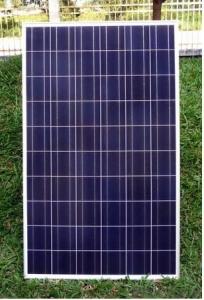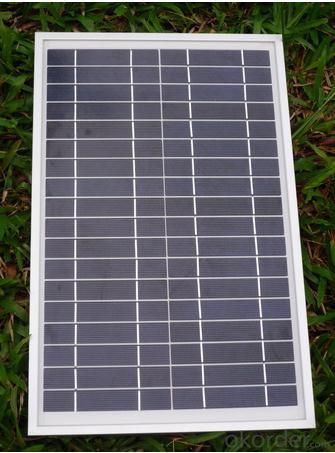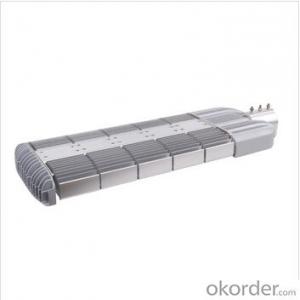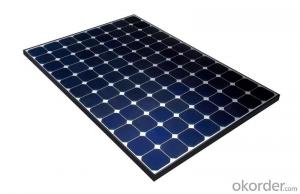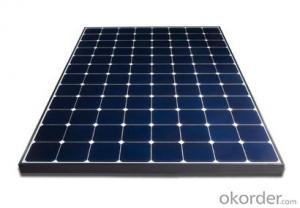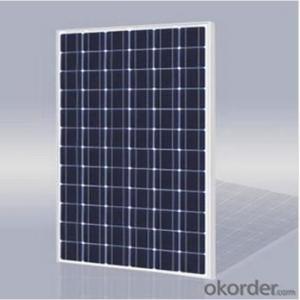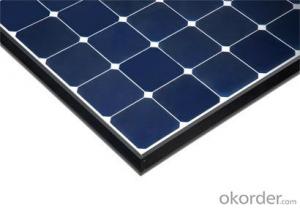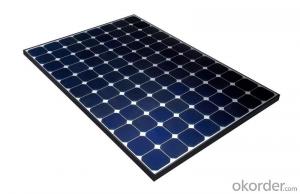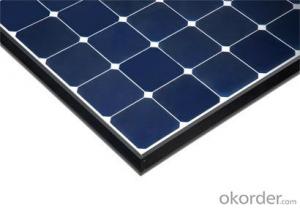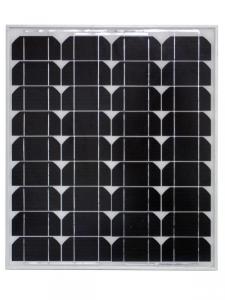Prius Solar Panels - Multicrystalline Solar Panel 165W A Grade for Commercial
- Loading Port:
- China main port
- Payment Terms:
- TT OR LC
- Min Order Qty:
- 1000 watt
- Supply Capability:
- 20000 watt/month
OKorder Service Pledge
OKorder Financial Service
You Might Also Like
Specification
Muticrystalline Solar Panel 155W A Grade For Commercial
Introduction
It is a form of photoelectric cell, defined as a device whose electrical characteristics, such as current, voltage, or resistance, vary when exposed to light. Solar cells are the building blocks of photovoltaic modules, otherwise known as solar panels.
Solar cells are described as being photovoltaic irrespective of whether the source is sunlight or an artificial light. They are used as a photodetector (for example infrared detectors), detecting light or other electromagnetic radiation near the visible range, or measuring light intensity.
In contrast, a solar thermal collector supplies heat by absorbing sunlight, for the purpose of either direct heating or indirect electrical power generation from heat. A "photoelectrolytic cell" (photoelectrochemical cell), on the other hand, refers either to a type of photovoltaic cell (like that developed by Edmond Becquerel and modern dye-sensitized solar cells), or to a device that splits water directly into hydrogen and oxygen using only solar illumination.
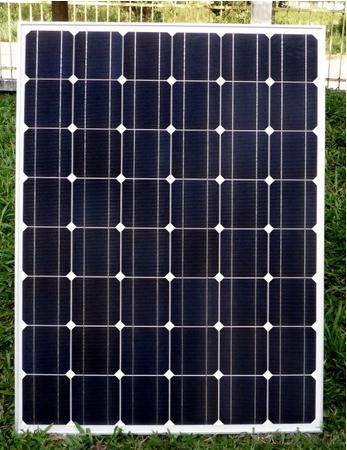
Suggested application
Home lighting business lighting,
Garden lighting, pavement lighting
Farmer household lighting
Product feature
modules are made of Monocrystalline or Polycrystalline Silicon cell.
Materials and color of the solar panel frame: Clear anodized aluminum alloy type 6063T5 Universal frame; Silver-white color;
The output connection gathers the coupling: Selects conforms to the IEC-612615; 2005, class II, IEC61730 international standard; Airtight waterproofing binding clamp;
Module seal structure: The surface is thick, the high diaphanous rate armored glass with solar cell board special-purpose 3.2mm becomes after the high temperature lamination craft. The back selects has waterproof and anti- aged performance fine TPT materials. The entire block battery board has, the waterproofing, the anti- aging airtight and so on the fine performance;
Power tolerance: +/-3%
Packaging
International standard cartons(according to the requirements of customers )
- Q: For a computer technology project we are using solar panels and trying to see different methods that will increase the output of solar power from these panels. For now, we have got polymer stickers and mirrors. Are there any more methods, or information that increase the solar power? Please and thank you :)
- Even the angle of a solar panel can increase it;s out put, if you point it towards the south, it will receive more light (or towards the light source if it is an artificial source) mirrors can also be place and angled around solar panels to gather and reflect more light to the panel, this is often done is solar water heating, but would work with a panel as well. Over all, solar panels are very efficient, it's our way of catching light that isn't.
- Q: Im doing a project and i have to persuade some one that solar pannels are great... help ?
- nan
- Q: i have this usb solar panel charger i am building and the solar panel is about 2by .5quot;, so i was wondering if a led light can power it, if so will one be good or would i need more? if so how many?
- Yes, shining light from a visible-light LED on a solar panel will cause the solar panel to generate electricity. There is a long-wavelength cutoff (probably in the near infrared) where photons from an infrared LED would not have sufficient energy per photon to excite the solar panel, no matter how bright the LED was. Of course the amount of electricity produced is a fraction of the power needed to power the LED. The best possible efficiency you could achieve under optimal conditions is about 30%. The typical optical power output of a single LED is around 0.3 Watt. The density of sunlight is such that the amount of sunlight falling on a 2 x .5 area perpendicular to the Sun's rays is about .3 Watts. So maybe you'd want a few LEDs, or a particularly bright LED to simulate sunlight. But you'll get something with one LED. A bright LED flashlight would work.
- Q: i want to know how to hook up solar panels to my existing power. all i can find on the internet is to use batteries and a inverter. but i want to use all of my existing lights and outlets off of the solar energy. i have heard that you can actually turn the meter backwards and use supplied power when needed. thats what i want to do and is it possible to do myself and if so, how?
- Contact your power company. They will advise you of the proper configuration. If you try to attempt this without notifying the power company and something goes wrong, they can and most likely will hold you responsible for all damages.
- Q: I have purchased a 2 volt LED lantern from argos, it comes with a built in 6 volt 4ah sealed acid battery. What I wanted to know is would I be able to charge it using my 6 volt solar panel?
- If it has a 6 volt battery- is it marked 2 volts on an external plug? If so, there is a resistor inside to drop the potential the battery sees. The battery itself could be slipped out and recharged easily from your 6 volt panel. Just determine how much current (in Amps or Milliamps) the panel produces nominally and divide that into 4 and add one fourth of that length of time to make up for system losses. This will tell you how many hours it should charge assuming your starting voltage of the battery is above .5 volts. and the panel is at 3 volts potential or higher. So if your panel puts out amp at 0AM, you would charge for 5 hours. 4 divided by is 4 and one fourth of that is so 4 plus is 5. It is a little more involved than that, but as a rule of thumb. Also do not discharge tha lantern to the point of no light output. LEDs are efficient, but their current will add up. If it is suggest to be able to use the lantern for up to 8 hours on a charge, stick to that value. Lead acid batteries have best longevity when discharged only to 80 percent capacity. Once battery is charged- disconnect from charging source.
- Q: I have a home made 24 volt electric cart. It is powered by two 2Volt deep cycle batteries. Since the motor runs on 24 volts the batteries are wired in series to produce the 24 volts. I only have a 2 volt battery charger, but I also have two 2 volt solar panels. It is a pain having to unhook wires, rewire it, or charge them one at the time.HERE IS THE QUESTION REALLY... Can I wire the two 2 volt solar panels together in series (ie: negative to positive) then connect it to the existing 24 volt system and have it charge the batteries fine. I know basic wiring, but I know nearly nothing about solar panels, will it work fine? will it cause them to break? or short out?(additional info, the solar panels are only rated at 5 amps so it will not overcharge the batteries or anything)
- Although I'm not experienced with solar panels, I would say no. if you wire them in series you'll actually be putting voltage through one of the panels. Can't believe this would be good. My suggestion would be to wire one panel to one battery and one panel to the other battery. I really don't believe there's a need to disconnect the batteries from each other. However if you would disconnect the one wire between the two batteries you would be guaranteed safe and I know that would work.
- Q: i am starting to consider getting solar panels instead of paying electric bills which are somewhat higher now than they used to be
- Budget okorder /
- Q: Do I just run the wire from the panel into the charge controller and then to the battery AND can I simultaneously draw energy from the battery while it is being charged by the panel?Is it as simple as hooking it up like that?
- I hope you have some instructions. You need safety switches and fuses in the circuit. What voltage/currents are you running? Don't burn the house down or get electrocuted please. DC can be very dangerous.
- Q: Can solar panels be used in remote areas with no access to the grid?
- Yes, solar panels can be used in remote areas with no access to the grid. Since solar panels generate electricity from sunlight, they can provide a reliable and sustainable source of power in off-grid locations. By harnessing the energy of the sun, solar panels can charge batteries or directly power electrical devices, making them an ideal solution for remote areas without access to the traditional power grid.
- Q: That one costs money but looks like it might work. I don't really have the money for it but if it works then it would probably be worth it. Do homemade solar panels really work or is it just a gimmick? I'm really interested to see if anyone has actually tried this and to see what they say about it.Thanks
- Yes there are plans and testimonials all over the internet and dozens of vids on youtube for homemade panels
Send your message to us
Prius Solar Panels - Multicrystalline Solar Panel 165W A Grade for Commercial
- Loading Port:
- China main port
- Payment Terms:
- TT OR LC
- Min Order Qty:
- 1000 watt
- Supply Capability:
- 20000 watt/month
OKorder Service Pledge
OKorder Financial Service
Similar products
Hot products
Hot Searches
